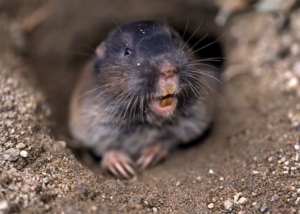By Sean Gilbert
Gophers and other underground pests can cause significant damage to fruit tree orchards if they are not dealt with in a timely manner. Young orchards in particular can see root systems destroyed that can set a block back for multiple seasons.

Northern pocket gopher (Courtesy Washington Department of Fish and Wildlife)
Spring is a great time to deal with these pests because they are becoming more active than in winter and they are easier to see than when grass has grown over their mounds.
One of our most common tools for control of gophers has been Fumitoxin, which must be applied by a pesticide handler trained to work with this rodenticide. While the product kills the animal through a release of phosphine gas once the pill comes in contact with water, the label instructions require the water to come from the soil and NOT from water added by the applicator to the hole.
While this is a very effective way to control the pest, it comes with significant risks to the applicator that must be addressed by the farmer prior to and during the application.
The first indicator of the dangerous nature of Fumitoxin is the prominent skull and crossbones on the label, indicating that if not handled properly it carries the risk of death or serious injury. Since its method for killing pests is through a release of a gas, one of the most important things to understand about the Fumitoxin label is the respiratory protection.
This past year our safety team conducted a test in conjunction with Ron Britt and Associates in Yakima to determine what respiratory protection was needed during our applications.
We found that in this case, using an MSA full face mask with an MSA phosphine/ammonia/chlorine/P100 canister was sufficient to cover the risk of exposure to the applicator. This level of respiratory protection is adequate for our application, following our standard operating procedures and may not be sufficient for other types of applications.
We were able to order the face mask and phosphine canister, as well as a Honeywell phosphine monitor online through the supplier’s websites.
Different variables such as temperature, soil moisture, and wind can all be factors that can affect the potential exposure an applicator would face so be sure to read all label requirements and know your employee’s situation. For growers in Washington State, there is a very helpful consultation service through the department of labor and industries and department of agriculture that can serve as a resource for any questions.
An important thing we have found in this process is that many alternatives to Fumitoxin exist that carry much lower risk to worker exposure. As one of many alternatives, our favorite method for gopher control is a device that is quick and easy to engage as well as to monitor called Gopher Hawk, available online or from local suppliers.
Sean Gilbert is General Manager of Gilbert Orchards in Yakima, Washington. He wrote this grower education essay as part of a settlement of a Washington Department of Labor and Industries case that began in 2015.






Leave A Comment